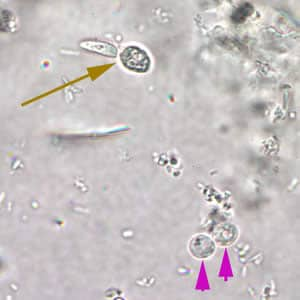Cryptosporidium Oocysts In Stool | Extraintestinal cryptosporidiosis can involve the lungs, middle ear, biliary tract, pancreas and stomach. Cryptosporidial oocysts when ingested are immediately infectious at quite low doses (10 to 30 oocysts are required to produce human disease). On h&e staining, developmental stages of cryptosporidium appear as small, spherical. After cryptosporidium oocysts are ingested, they excyst in the gastrointestinal tract and release sporozoites, which parasitize gastrointestinal epithelial cells. An infected person can pass 3 to 6 liters of watery stool per day, making the u.s.
Cryptosporidiosis is caused by members of the genus cryptosporidium, a coccidian parasite in the family cryptosporidiidae, subclass cryptogregaria and phylum apicomplexa. Small blue organisms at luminal border. Infection is initiated when oocysts are ingested and excyst in. It spreads through food and water. Cryptosporidiosis is an intestinal disease caused by the cryptosporidium parasite.

All msr microfilters and purifiers meet this standard. Threshold of detection of cryptosporidium oocysts in human stool specimens: Fredes, fernando díaz, angela raffo, eduardo and muñoz, pamela 2008. Later, they're shed in your feces. Sources and species of cryptosporidium oocysts in the wachusett reservoir watershed. Sporozoites are sometimes visible inside the oocysts, indicating that sporulation has occurred. Cryptosporidial oocysts when ingested are immediately infectious at quite low doses (10 to 30 oocysts are required to produce human disease). Cryptosporidiosis, sometimes informally called crypto, is a parasitic disease caused by cryptosporidium, a genus of protozoan parasites in the phylum apicomplexa. Human illness was formerly thought to be caused by a single species, but molecular studies have demonstrated that it is caused by at least 15 different species. It spreads through food and water. Read about symptoms, diagnosis, risk, transmission, incubation period, treatment, prevention, and statistics. Cryptosporidium is phylogenetically related to toxoplasma gondii, isospora belli, and sarcocystis species. Therefore, stool specimens should be preserved in formalin to render oocyts nonviable.
Demonstration of cryptosporidium in intestinal fluid or small bowel biopsy specimens 3. Weber r, bryan r, bishop h, wahlquist sp, sullivan jj, juranek dd. Evidence for low sensitivity of. All msr microfilters and purifiers meet this standard. Human illness was formerly thought to be caused by a single species, but molecular studies have demonstrated that it is caused by at least 15 different species.

Comparison of current methods used to detect cryptosporidium oocysts in stools. Evidence for low sensitivity of. Human cryptosporidiosis is caused by infection with apicomplexan protozoans of the genus cryptosporidium. In this review all of the methods that are currently in use for the investigation of cryptosporidium in stool material are highlighted and critically discussed. An infected person can pass 3 to 6 liters of watery stool per day, making the u.s. On h&e staining, developmental stages of cryptosporidium appear as small, spherical. All msr microfilters and purifiers meet this standard. Read about symptoms, diagnosis, risk, transmission, incubation period, treatment, prevention, and statistics. Oocysts are rounded and measure 4.2 to 5.4 µm in diameter. Human illness was formerly thought to be caused by a single species, but molecular studies have demonstrated that it is caused by at least 15 different species. Treatment may involve antiparasitic drugs. Infection is initiated when oocysts are ingested and excyst in. Epa calls for removal or inactivation of 99.9% of cryptosporidium oocysts in drinking water.
Evidence for low sensitivity of. Infection is initiated when oocysts are ingested and excyst in. Later, they're shed in your feces. An infected person can pass 3 to 6 liters of watery stool per day, making the u.s. Ingested oocysts excyst in stomach and small intestine, releasing 4 infective sporozoites that bind to intestinal epithelial cells.
Cryptosporidial oocysts when ingested are immediately infectious at quite low doses (10 to 30 oocysts are required to produce human disease). Weber r, bryan r, bishop h, wahlquist sp, sullivan jj, juranek dd. Cryptosporidiosis, sometimes informally called crypto, is a parasitic disease caused by cryptosporidium, a genus of protozoan parasites in the phylum apicomplexa. Threshold of detection of cryptosporidium oocysts in human stool specimens: All msr microfilters and purifiers meet this standard. Furthermore, there is no standardization for the protocols that are commonly used to either detect oocysts in faeces or to diagnose the. Sources and species of cryptosporidium oocysts in the wachusett reservoir watershed. To maximize recovery of oocysts, stool specimens should be concentrated prior to microscopic examination. Cryptosporidiosis typically causes terrible bouts of watery diarrhea. Human cryptosporidiosis is caused by infection with apicomplexan protozoans of the genus cryptosporidium. Later, they're shed in your feces. Sporozoites are sometimes visible inside the oocysts, indicating that sporulation has occurred. Small blue organisms at luminal border.
Comparison of current methods used to detect cryptosporidium oocysts in stools cryptosporidium oocyst. Later, they're shed in your feces.
Cryptosporidium Oocysts In Stool: It spreads through food and water.
Source: Cryptosporidium Oocysts In Stool